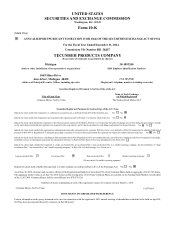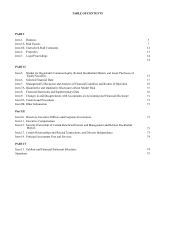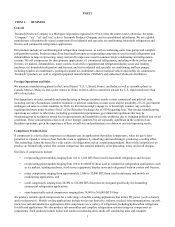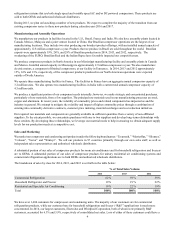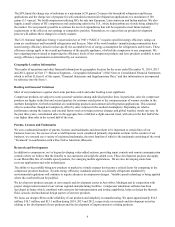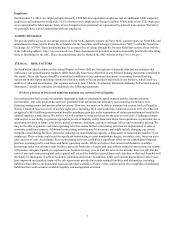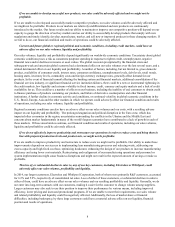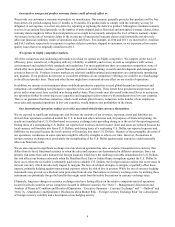Tecumseh Products 2014 Annual Report Download - page 11
Download and view the complete annual report
Please find page 11 of the 2014 Tecumseh Products annual report below. You can navigate through the pages in the report by either clicking on the pages listed below, or by using the keyword search tool below to find specific information within the annual report.9
Increased or unexpected product warranty claims could adversely affect us.
We provide our customers a warranty on products we manufacture. Our warranty generally provides that products will be free
from defects for periods ranging from 12 months to 36 months. If a product fails to comply with the warranty, we may be
obligated, at our expense, to correct any defect by repairing or replacing the defective product. Although we maintain warranty
reserves in an amount based primarily on the number of units shipped and on historical and anticipated warranty claims, future
warranty claims might not follow historical patterns or we might not accurately anticipate the level of future warranty claims.
An increase in the rate of warranty claims or the occurrence of unexpected warranty claims could materially and adversely
affect our financial condition, results of operations and cash flows. For example, in 2014 and 2013, we incurred $11.4 million
and $14.5 million, respectively in expenses to replace defective products shipped to customers, as we experienced two major
quality issues that were originally identified in 2013.
We operate in highly competitive markets.
All of the compressor and condensing unit markets in which we operate are highly competitive. We compete on the basis of
efficiency, price, sound level, refrigerant, delivery, reliability, availability and service, as well as compliance with various
environmental and regional safety standards and regulations. For most applications there are numerous competitors, some of
which offer more products and have greater financial, technical, manufacturing, research and development and management
resources than we do. Products in some markets are relatively undifferentiated and competitors are continuously introducing
new products. If our products do not meet or exceed the attributes of our competitors' offerings, we could be at a disadvantage
in the affected product lines. These and other factors might have a material adverse effect on our results of operations.
In addition, we operate in environments where worldwide productive capacities exceed global demand and customers and
competitors are establishing new productive capacities in low cost countries. These trends have put downward pressure on
prices and in some cases have resulted in us losing market share. These trends may also result in the need for us to restructure
our operations further by removing excess capacities and engaging in joint ventures with manufacturers in low cost countries.
There is no guarantee that these initiatives, which could include plant closures, reductions in the number of our employees,
asset sales and expanded operations in low cost countries, would improve our profitability in the future.
Our international operations subject us to risks associated with foreign currency fluctuations.
We are exposed to significant exchange rate risk because the majority of our revenues, expenses, assets and liabilities are
derived from operations conducted outside the U.S. in local and other currencies and, for purposes of financial reporting, the
results are translated into U.S. Dollars based on currency exchange rates prevailing during or at the end of the reporting period.
During times of a strengthening U.S. Dollar, our reported net revenues and net income (loss) and assets are reduced because the
local currency will translate into fewer U.S. Dollars, and during times of a weakening U.S. Dollar, our reported expenses and
liabilities are increased because the local currency will translate into more U.S. Dollars. Because of the geographic diversity of
our operations, weaknesses in some currencies might be offset by strengths in others over time. However, fluctuations in
foreign currency exchange rates, particularly the strengthening of the U.S. Dollar against major currencies could materially
affect our financial results.
We are also exposed to significant exchange rate risk when an operation has sales or expense transactions in a currency that
differs from its local, functional currency or when the sales and expenses are denominated in different currencies. Since our
primary risk stems from sales transacted at foreign locations which have the resulting receivable denominated in U.S. Dollars,
this risk affects our business adversely when the Brazilian Real, Euro or Indian Rupee strengthens against the U.S. Dollar. In
these cases, when the receivable is ultimately paid in less valuable U.S. Dollars, the foreign location realizes less net revenue in
its local currency, which can adversely impact its margins. We have developed strategies to mitigate or partially offset these
impacts, primarily hedging against transactional exposure where the risk of loss is greatest. While the use of currency hedging
instruments may provide us with short-term protection from adverse fluctuations in currency exchange rates, by utilizing these
instruments we potentially forego the benefits that might result from favorable fluctuations in currency exchange rates.
Ultimately, long term changes in currency exchange rates have lasting effects on the relative competitiveness of operations
located in certain countries versus competitors located in different countries. See “Item 7 – Management’s Discussion and
Analysis of Financial Condition and Results of Operations – Executive Summary – Currency Exchange” and “—Outlook” and
“Item 7A – Quantitative and Qualitative Disclosures about Market Risk – Foreign Currency Exchange Risk” for a description
of foreign currency volatility and a description of our hedging activity.



